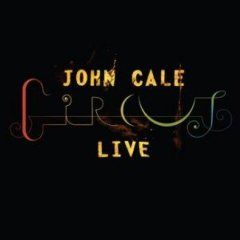
Rating: 7.5
Lou Reed has always received the most credit for what is widely known as the incredible legacy of the Velvet Underground. The name John Cale, although it does conjure up an instant association with the aforementioned group, usually draws a blank with most people concerning his solo output from 1968 until the present. This is hugely due to the overwhelming lack of hit material that he has produced. However, those who have seen him as a vital presence as being at least equally important as Lou Reed in defining the Velvet Underground’s place in music history, have discovered that Cale’s solo career has consistently outshined Reed’s by leaps and bounds. To be succinct, his records contain a fine balance between pop, classical, and avant-garde music. His albums, for the most part, are both intelligent and challenging where Lou Reed’s often suffer from a prevalent tendency towards average good time rock and roll. When considering this point, it is obvious why the first two Velvet Underground records are so different from the third and fourth. The fact of the matter is that John Cale is an astonishingly original multi-instrumentalist and songwriter. The new double CD collection Circus Live was recorded mostly during the tour that followed 2005’s excellent BlackAcetate.
So, what do we have in this assembly to evaluate Mister Cale? To start, there are a couple of updated versions of songs that originally appeared on the first Velvet Underground album in 1966. Circus Live begins with a storming rendition of “Venus in Furs” and he sounds great as the lead vocalist on this song. It doesn’t feel like the track is lacking anything, least of all Lou Reed. There is also something a little more typically experimental of Cale here in the form of “Femme Fatale.” which includes a hefty portion of his 1979 b-side “Rosegarden Funeral of Sores.” It is well known that John Cale and Nico were collaborators throughout their careers and this is where he pays homage to the chanteuse, as he tends to do at least once in his sets. In the middle of the track, he delves into the erratic, paranoia of the obscure solo track, which is a highlight of his back catalog. Bauhaus even covered it on their first album.
Speaking of paranoia, a trademark of Cale’s that characterizes three indispensable albums that he did on Island Records in the mid seventies, he revisits some of this material in live renditions on Circus with familiar, but refreshed harmonic skill. There is a much slowed down, nearly thirteen mintute version of the classic dirge “Gun.” Also included from 1974’s Fear is an updated arrangement of the beautiful, shimmering “Buffalo Ballet,” which is an indication that he is just as talented at writing melancholy ballads as he is at writing hysterical, often brooding melodies such as “Save Us,” from Helen of Troy. From this recording he also performs “The Ballad of Cable Hogue.” This song is a personal favorite as it features the juxtaposition of gentile acoustic guitar with Cale’s intense shrieking scream, one that appears on many of his recordings. This version is slightly marred by a somewhat lame, Peter Frampton sounding guitar solo, but I’ll forgive him with this much. The other key record in this Island Records trilogy is called Slow Dazzle and it is represented by the grimy back alley rhythm of “Dirty Ass Rock and Roll.”
Admittedly, John Cale’s output was fairly sporadic concerning highlights from 1981 until 2000, but he has produced solid back to back albums in the past five years with Hobosapiens and BlackAcetate. Both of these albums showcase how well an aging veteran in rock music can easily crush the competition of younger groups in terms of creativity and originality. The former is lush, swirling, dancey and almost ambient whereas his most recent studio album contains a heavier rock feel while retaining his expected experimental side. An example of it’s sound is in the song “Woman.” Both of these studio records are noteworthy and reveal how he can switch from one genre to another almost effortlessly. “Look Horizon” and the dreamlike cadence of “Magritte” hail from Hobosapiens. These two songs don’t feel at all out of place amongst the classic material in this live set.
Included at the end of this collection are four songs from a show in the Netherlands in 2003 in support of Hobosapiens dubbed the “Amsterdam Suite.” These versions are all done in slower, more keyboard heavy arrangements as the album features. These tracks offer a contrast to the main set, which further indicate how Cale can successfully perform from alternate avenues. The second disc ends with an instrumental drone track, and as it does I am forced to decide what I to listen to next. Instead of putting something else new on, I will just sit here in silence and hope that someday I will actually get to see him live on stage.
-Andrew Boe